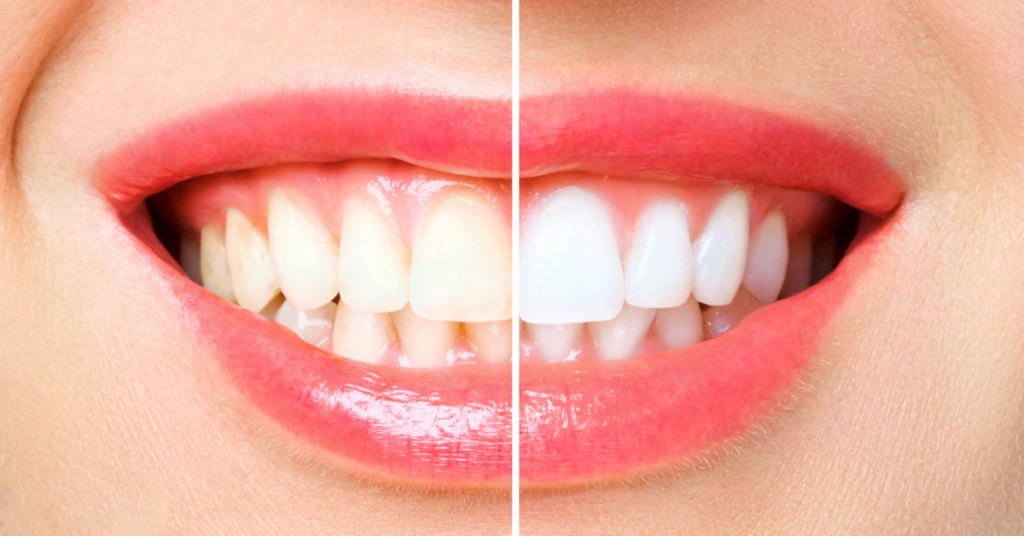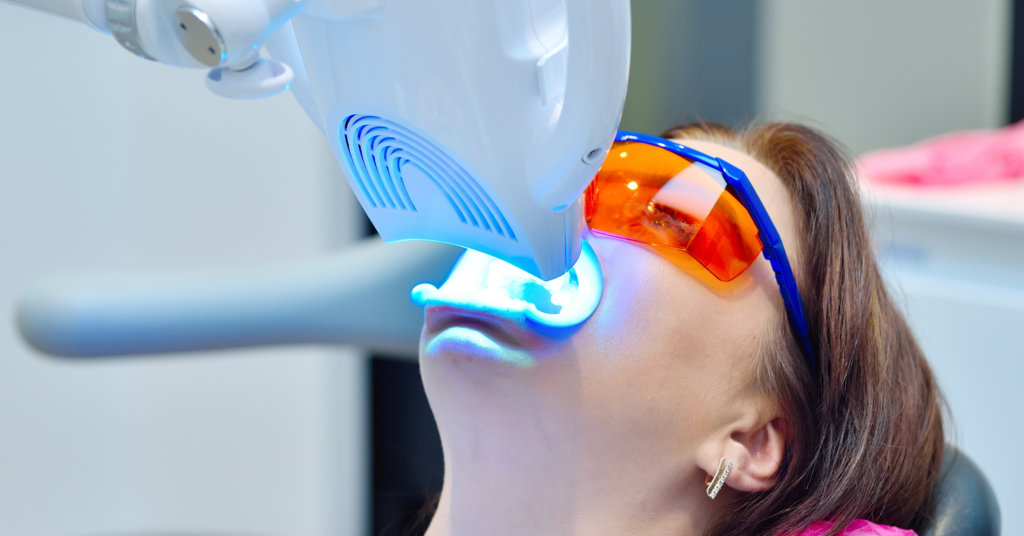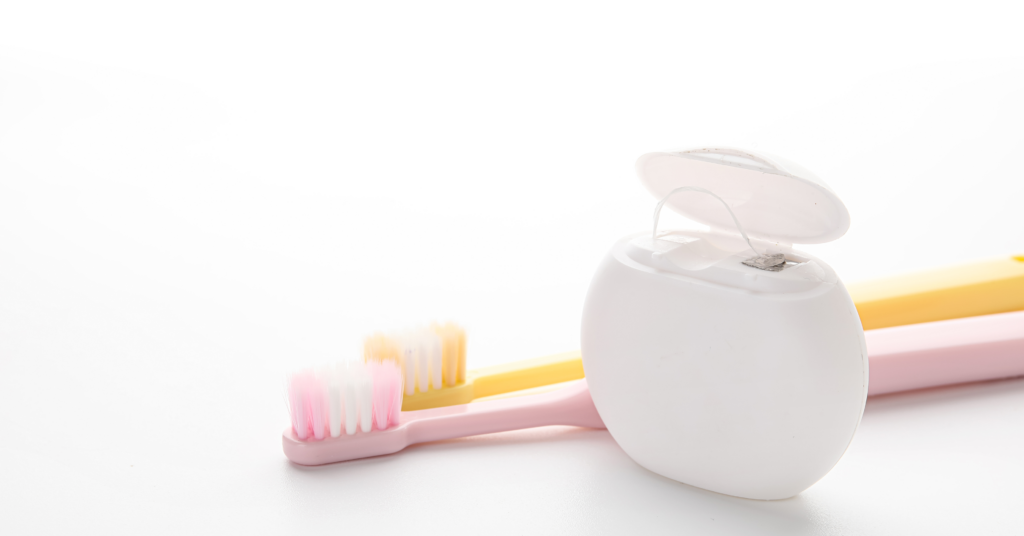No More Yellow Teeth: Understanding Tooth Whitening Options


Everyone wants a bright and healthy smile, and tooth whitening is a popular way to achieve it. Tooth whitening can help remove stains and discoloration caused by a variety of factors, including food and drinks, smoking, and aging. In this article, we will explore the various tooth whitening options available, the benefits of whitening your teeth, and the risks and aftercare tips to keep your newly whitened smile shining bright.
What is Tooth Whitening and How Does it Work?


Tooth whitening is a cosmetic dental procedure that uses various techniques and products to remove stains and discoloration from the surface of the teeth. The process of tooth whitening works by breaking down the pigments that cause discoloration, making the teeth appear brighter and whiter.
Types of Tooth Whitening Methods
There are several types of tooth-whitening methods available, including:
- In-office whitening: This method involves a dentist applying a professional-grade bleaching gel to the teeth and using a special light to activate the gel. This process typically takes about an hour and can produce significant results in just one visit.
- At-home whitening: This method involves the use of custom-fitted trays and a bleaching gel that is worn for a specified amount of time each day. At-home whitening can take several weeks to produce results but can be a more convenient and affordable option for those who prefer to whiten their teeth in the comfort of their own home.
- Over-the-counter whitening products: This category includes toothpaste, strips, and gels that are available for purchase at your local drugstore. Over-the-counter whitening products can be an affordable option, but they may not produce the same level of results as professional whitening methods.
The Benefits of Tooth Whitening


Tooth whitening has several benefits, including:
- Improved appearance: The most obvious benefit of tooth whitening is a brighter, more attractive smile. This can boost self-confidence and make a positive impact on personal and professional relationships.
- Removes stains and discoloration: Tooth whitening can effectively remove stains and discoloration caused by a variety of factors, including food and drinks, smoking, and aging.
- Non-invasive procedure: Tooth whitening is a non-invasive procedure that does not require any drilling or alterations to the teeth.
How to Choose the Right Tooth Whitening Method for You
When choosing a tooth whitening method, it’s important to consider several factors, including:
- The degree of discoloration: If you have severe discoloration, in-office whitening may produce the best results. For mild to moderate discoloration, at-home whitening or over-the-counter products may be sufficient.
- Timeframe: If you need results quickly, in-office whitening may be the best option. At-home whitening can take several weeks to produce results but can be a more convenient option.
- Budget: Professional whitening methods tend to be more expensive than over-the-counter products, but can produce more significant results.
- Convenience: At-home whitening and over-the-counter products can be a more convenient option for those who prefer to whiten their teeth in the comfort of their own home. When choosing a tooth whitening method, it’s important to consider several factors, including the degree of discoloration, timeframe, budget, and convenience, as well as using the right toothbrush and toothpaste for maintaining your oral hygiene.
Risks and Side Effects of Tooth Whitening
While tooth whitening is generally considered safe, there are some potential risks and side effects, including:
- Sensitivity: Some people may experience temporary tooth sensitivity after whitening. This is caused by the bleaching agents reaching the nerves inside the teeth. The sensitivity should subside within a few days after the whitening process is complete.
- Irritation of the gums: If the whitening gel comes into contact with the gums, it can cause irritation and inflammation. This is why it’s important to follow the instructions carefully and use the product as directed.
- Uneven results: Tooth whitening may not produce uniform results, with some teeth appearing lighter or whiter than others. This can be due to variations in the amount of stain or discoloration on each tooth.
- Chemical reactions: In rare cases, some people may experience chemical reactions to the bleaching agents used in tooth whitening. This can cause itching, burning, or redness of the gums or lips. While tooth whitening is generally considered safe, there are some potential risks and side effects. If you’re nervous about the procedure, consider reading about how to overcome dental anxiety to help ease your concerns.
Aftercare Tips for Maintaining Your White Teeth


To maintain your newly whitened smile, it’s important to follow these aftercare tips:
- Avoid staining foods and drinks: Certain foods and drinks, such as coffee, tea, red wine, and tobacco, can cause discoloration of the teeth. Try to limit your consumption of these items or brush your teeth immediately after consuming them.
- Brush and floss regularly: Regular brushing and flossing will help remove plaque and prevent new stains from forming on the teeth.
- Use a whitening toothpaste: Using a whitening toothpaste can help remove surface stains and maintain the brightness of your newly whitened teeth.
- Visit your dentist regularly: Regular dental check-ups and cleanings can help prevent new stains from forming and keep your teeth healthy and bright. Regular dental visits also give you the opportunity to connect with supportive dentists who have your best interests in mind.
- Consider touch-up treatments: Touch-up treatments, such as at-home whitening kits or professional treatments, can help maintain the brightness of your teeth and keep them looking their best. It’s important to follow the manufacturer’s instructions and use touch-up treatments as directed.
- Protect your teeth from further damage: To protect your newly whitened teeth, it’s important to wear a mouthguard when playing sports or grinding your teeth at night. You should also avoid using tobacco products, which can cause discoloration and damage to the teeth. You should also consider dental sealants as an additional preventive measure for maintaining your oral health.
- Consider the cost: Tooth whitening can be an investment, and the cost can vary depending on the method you choose. Be sure to research your options and choose the method that works best for your budget and your desired results.
- Consult with your dentist: Before starting any whitening treatment, it’s important to consult with your dentist to determine if it’s safe for you and to discuss any potential risks or side effects. Your dentist can also recommend the best whitening method for your individual needs and help you achieve the best results.
In conclusion, tooth whitening is a popular and effective way to achieve a brighter, more attractive smile. Whether you opt for professional whitening or an at-home solution, it’s important to understand the benefits, risks, and aftercare tips to ensure the best results and maintain your white teeth for years to come.
If you’re looking to achieve a brighter, more confident smile, don’t hesitate to take the first step towards your dream smile today. Our experienced and compassionate white rock dentists are here to guide you through the tooth whitening process and help you choose the best method for your needs. We offer a range of professional services, from in-office whitening treatments to customized at-home solutions, to help you achieve and maintain your ideal smile. Don’t let discolored teeth hold you back any longer – schedule a consultation with our skilled team and start your journey towards a radiant smile today!